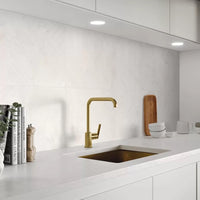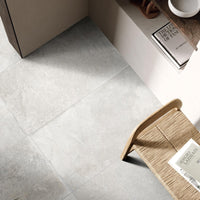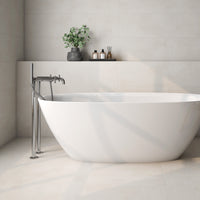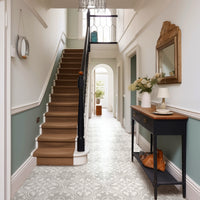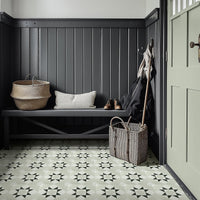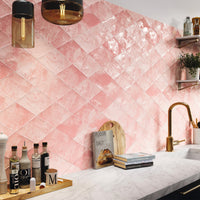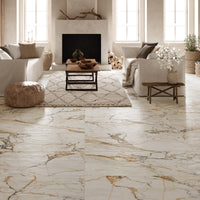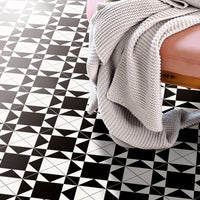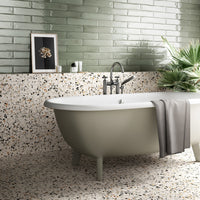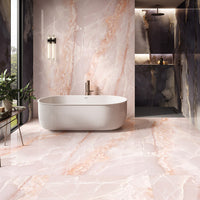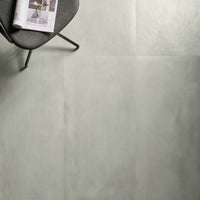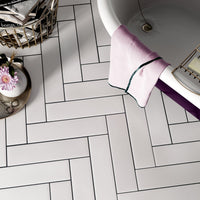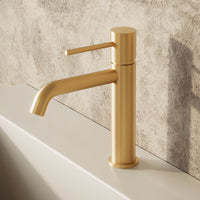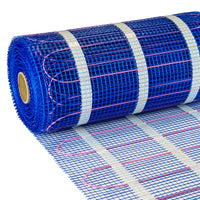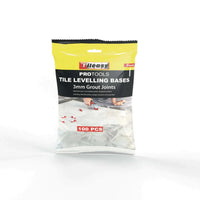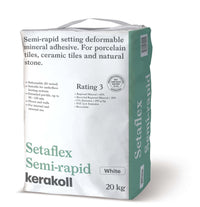We’re often asked what the difference is between
wall and
floor tiles. Surely it’s pretty easy - wall tiles are wall tiles and floor tiles are floor tiles, right? Well actually, no. In the past, the difference between wall and floor tiles was as clear as day and night. However these days, due to design trends and improved technology there’s a lot of crossover between the two. And this can be a little confusing, especially if you’re a little new to tiles. To give you an example, here’s two misnomers we hear from time to time: 1 -
“ceramic tiles are for walls; porcelain tiles are for floors” 2 -
“small tiles are for walls; large tiles are for floors” Both are incorrect - in theory, you could have a large porcelain tile on your wall, or a small ceramic tile on your floor. As a responsible tile retailer, it’s up to us to set the record straight. So this short article will cover the key differences between wall and floor tiles, helping you clear the picture.
What’s a floor tile?
Easy answer, a tile that can be used on the floor! For obvious reasons, floor tiles need to be quite strong and able to resist wear and tear. After all, no-one wants their new kitchen floor to crack or wear away after just a few months! Here at Porcelain Superstore we use the
PEI Rating to determine which tiles can be used on floors. This rates tiles for
'resistance to wear' on a scale from 0 to 5. A rating of 0 means a tile can only be used on the wall, whereas a tile with a rating of 5 is extremely tough and can be used on extremely busy floors. So technically speaking, any tile with a PEI rating from 1 to 5 can be used on floors and is, therefore,
a floor tile.
But not all floor tiles are born equal
Floor tiles can be made from either ceramic or porcelain (and even from natural stones such as marble and travertine). In general, ceramic tiles tend to be softer and less resistant to wear and tear. This means they’re perfectly fine for bathrooms, kitchens and floors around the home, but might not be suitable for busy commercial spaces such as bars and restaurants. On the other hand, porcelain tiles are extremely dense and hard-wearing. Therefore they’re able to withstand a lot more daily foot traffic. So in general, a porcelain tile can be used on pretty much any floor at home, as well as the majority of ‘light’ commercial floors such as bars, shops and restaurants. It always pays to check the PEI rating of any tile if you’re a little unsure.
What’s a wall tile?
Technically speaking,
wall tiles have a rating of 0 on the PEI scale. It's best to call these wall-only tiles as they can't bear much weight and certainly can't be used on floors. However, they make super choices for kitchen splashbacks and shower walls; they’re relatively easy to install and a doddle to wipe clean. And that's pretty important - after all, you don’t want to waste time wiping grease or oils off your shiny new splashback!

In general, wall only tiles tend to be smaller and made from ceramic - the classic wall tile you might have in your mind. If you take a gander at our
Albert's Racing Green tiles in the image above you'll see the pale ceramic base and the thin layer of deep green glaze applied on top. Many other wall only tiles have a similar brick shape that perfectly chime with today's trend for modern subway tiles.
But - floor tiles can be used on walls
So to clarify, tiles with a PEI rating of 0 are classified as wall-only tiles. But there’s no reason why you can’t use tiles with a PEI rating of 1 to 5 -
i.e. floor tiles - on your walls. Yes, you read that right - you can use floor tiles on your walls! But why would you want to do this? Well, there's quite a few reasons actually. Let's take a closer look:
1 - Follow the trend for larger tiles
One of the hot trends at the moment is for
large format floor tiles, which to us are tiles that measure 60 x 60 cm or larger. These look great when laid over a large floor area such as a garden room; but they’re also perfect on smaller bathroom walls. With more tile and fewer grout joints, they’ll give an illusion of more space. You can achieve this designer look with our Bistrot Calacatta range - your walls will look like they've been clad in expensive Italian marble.
2 - Modern design aesthetic
If you’re a fan of minimal design, you’ll love the fashion for running the same floor tiles up your bathroom walls, as shown with our
Concrete Grey tiles below. This is a great way to instil a sense of calm into the room - for maximum effect, opt for larger tiles and ensure the grout joints run from floor to wall unbroken.

3 - More design possibilities
These days, thanks to ‘digital printing’ machines there’s a whole host of amazing tile designs that are more lifelike than ever. The amount of shapes, styles and sizes that tiles are available in is quite staggering - we’ve got everything from
tiny mosaics to
hexagon tiles,
modern bricks and classic
wood-effect planks.

Although many of these are produced as floor tiles, we think it’s best to think of them as wall and floor ‘coverings’ and it’s up to you, the customer, to choose where to lay them. And why wouldn’t you want to dress up your walls in tasty looking tiles, especially when they look as good as
Antique Marble or our Memory Cement hexagons? It’s a great way to turn a practical feature into a standout statement.
4 - Highly polished tiles
Highly polished tiles are relished for their luxurious style and are particularly popular if you’re after the wow effect. But why limit their mirrored magic to your floors when they’ll add instant glam to walls as well? Combining two or more colours of plain polished tiles has always been popular in bathrooms but we’ve recently spotted a trend for using polished marble effect tiles as kitchen splashbacks. These give the impression of a slab of exquisite marble, without the hefty price tag and hassle of maintenance.

In the image above, the left half shows an expensive natural marble splashback. The right half shows our Bistrot Calacatta tile, which looks almost exactly the same!
But, because there’s always a but…
This doesn’t necessarily mean you can lay any floor tile on any wall. It's vital to consider the weight of the tiles and adhesive to make sure your wall can bear the load. If you’re fitting tiles to a solid wall or tile backing board then you should be fine. However if you’re planning to fit large-format tiles onto a skimmed wall then you might exceed the weight limit that the plaster can bear.
This article explains things in a little more detail. If you’re still a little unsure, it’s best to get in touch or ask your tiler for advice. But remember - never use a wall only tile on the floor! Unless you happen to like cracked tiles, you won't be a happy bunny.
To sum things up
To be honest, we think the old way of seeing tiles as either 'wall' or 'floor' is a little old-fashioned. With all the advances in design and technology, it's a really exciting time in the tile world and the boundaries between bathroom, kitchen, wall and floor tiles is becoming ever more blurry. Of course, wall-only tiles will always have a place and their small size means they're inherently full of character. However, next time you're out shopping for wall tiles we'd really recommend taking a look across the whole tile spectrum before making up your mind - you really will be mesmerised by the stunning designs and styles on offer.
 In general, wall only tiles tend to be smaller and made from ceramic - the classic wall tile you might have in your mind. If you take a gander at our Albert's Racing Green tiles in the image above you'll see the pale ceramic base and the thin layer of deep green glaze applied on top. Many other wall only tiles have a similar brick shape that perfectly chime with today's trend for modern subway tiles.
In general, wall only tiles tend to be smaller and made from ceramic - the classic wall tile you might have in your mind. If you take a gander at our Albert's Racing Green tiles in the image above you'll see the pale ceramic base and the thin layer of deep green glaze applied on top. Many other wall only tiles have a similar brick shape that perfectly chime with today's trend for modern subway tiles.

 Although many of these are produced as floor tiles, we think it’s best to think of them as wall and floor ‘coverings’ and it’s up to you, the customer, to choose where to lay them. And why wouldn’t you want to dress up your walls in tasty looking tiles, especially when they look as good as Antique Marble or our Memory Cement hexagons? It’s a great way to turn a practical feature into a standout statement.
Although many of these are produced as floor tiles, we think it’s best to think of them as wall and floor ‘coverings’ and it’s up to you, the customer, to choose where to lay them. And why wouldn’t you want to dress up your walls in tasty looking tiles, especially when they look as good as Antique Marble or our Memory Cement hexagons? It’s a great way to turn a practical feature into a standout statement.
 In the image above, the left half shows an expensive natural marble splashback. The right half shows our Bistrot Calacatta tile, which looks almost exactly the same!
In the image above, the left half shows an expensive natural marble splashback. The right half shows our Bistrot Calacatta tile, which looks almost exactly the same!
